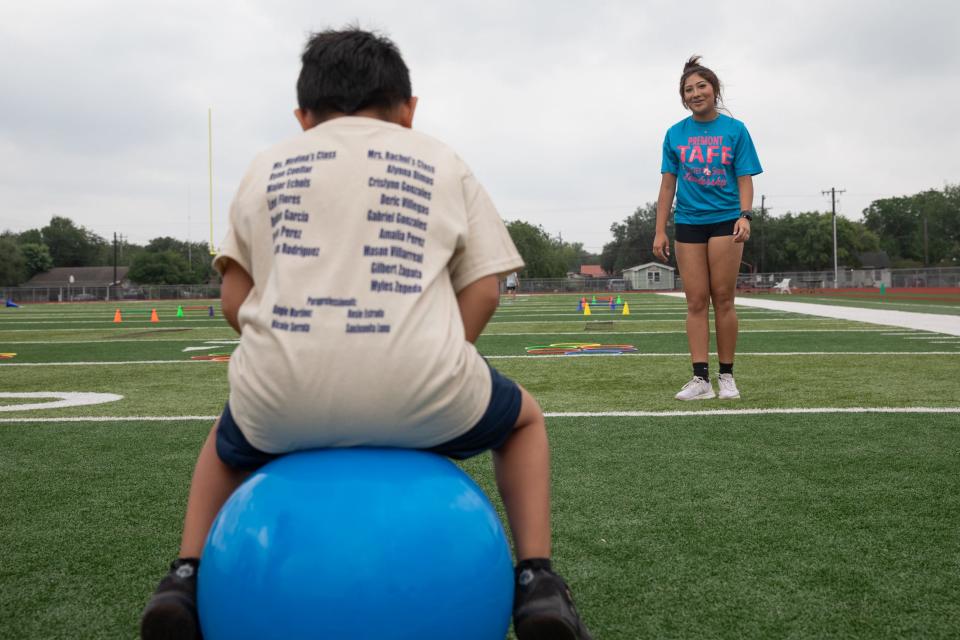Rural Schools Innovation Zone in South Texas grows with state support
In cities, students who dream about becoming nurses, welders, engineers, veterinarians, dentists, maritime workers, cosmetologists, mechanics and more can start learning about those career paths and even earning industry certifications while still in high school.
In small, rural school districts, there are often simply fewer career and technical education opportunities.
But through the Rural Schools Innovation Zone, rural school districts across Duval, Jim Wells, Brooks and Nueces counties have found a way to collaborate across school district boundaries.
“There’s no way each individual district could house five specialized career pathway academies based on resources, funding and staffing,” RSIZ executive director and former Premont Collegiate High School principal Michael Gonzalez said.
But together, they can.
Premont ISD, Freer ISD and Brooks County ISD are the original participants in the Rural Schools Innovation Zone, formed about five years ago to pool funding, talent and enrollments.
Core to the effort is the belief that rural students deserve every opportunity to access career paths and post-secondary success.
Despite the interruption of the COVID-19 pandemic in the early days of the collaboration, the effort has grown, adding Agua Dulce ISD and Benavides ISD
Between 2018-19 and 2020-21, the three original school districts quadrupled the percentage of students who completed a dual credit course. The districts outperform state and regional averages in college, career and military readiness factors, including student completions of industry-approved certifications and graduation rates.
Additionally, the collaboration inspired legislation in 2023 to establish the Rural Pathway Excellence Partnership program.

How did the Rural Schools Innovation Zone come about?
A decade ago, Premont ISD was struggling. The district had repeatedly fallen short on academics and faced the threat of closure from the state in the early 2010s.
In 2013, the district partnered with Texas A&M University-Kingsville to monitor student performance and mentor teachers. The university also helped the district secure millions in grant funding. By 2016, the district was on the rebound, meeting state academic standards for the first time since 2011.
Between 2017-18 and 2021-22, the district has received “B” ratings from the Texas Education Agency.
But as a small, rural district in South Texas, it still faced challenges. With low student populations and limited resources, districts like Premont ISD and its neighboring school districts cannot offer nearly as many programs and electives as larger suburban and urban districts.
Both Freer ISD and Premont ISD have about 700-800 students each in pre-K through grade 12. Brooks County ISD is a bit larger, reporting 1,244 students to the Texas Education Agency in 2023-24. Agua Dulce ISD and Benavides ISD both have less than 500 students.
In 2017, Steve VanMatre, who now leads Tuloso-Midway ISD, took over as superintendent of Premont ISD, bringing with him connections to other area educators and school leaders.
Before coming to Premont, VanMatre led Freer ISD, which has launched a health science program through grant funding. Conrad Cantu, who previously was Freer High School principal, took over as Freer ISD superintendent after VanMatre left.
VanMatre and Cantu devised a handshake agreement through which Premont ISD could send students to the Freer ISD health science program. In return, Premont ISD pitched in financially, ensuring Freer ISD could afford to maintain the program.
VanMatre also turned to then-Brooks County ISD Superintendent Maria Rodriguez-Casas, whose district was offering a welding program.
The three districts soon formalized an agreement, forming the Rural Schools Innovation Zone in 2019.
“Originally, it was just Premont students being shipped off,” Gonzalez said. “When the collaboration started, it was about pooling our resources and our efforts to give all three school districts the same opportunity that Premont was getting.”
Initially, RSIZ was structured as an in-district charter, with the zone managing four charter schools across three school districts. The zone is led by a board of directors and a full-time executive director, Michael Gonzalez.
The zone was funded initially through school action and school redesign grant awards from the Texas Education Agency and Texas Higher Education Coordinating Board Perkins CTE funding. In 2021-22 it transitioned to a funding model based on per-pupil funding, CTE funding and college, career and military readiness outcomes-based bonuses.
By 2022, the zone was supporting five academy programs.
In 2023, Agua Dulce ISD and Benavides ISD joined the zone.
Texas lawmakers approved a program to incentivize and support multidistrict rural college and career pathway partnerships in 2023.
Through the RSIZ, students at any of the five districts can take part in Brooks County ISD’s Ignite Technical Institute, Brooks County ISD’s naval JROTC program, Freer ISD’s Next Generation Medical Academy, Premont ISD’s Will Zelaya STEM Discovery Zone or Premont ISD’s Grow Your Own Educator Academy.

“We’ve got 190 kids in our high school and we can’t afford to offer all the different variety of classes and options,” Cantu said. “But, by sharing resources, we’re able to offer that variety of classes and share that cost with each other.”
Five years in, the Rural Schools Innovation Zone remains committed to re-inventing the rural school experience through collaboration, providing pathways for post-secondary success for students.
“There have been significant improvements in accountability ratings based on what we’ve done in the zone and through the work of our partners, our school districts and our local boards and superintendents,” Gonzalez said.
Mike Barrera is the current superintendent of Premont ISD.
“We’re working really hard to keep it together and grow it,” Barrera said.
Barrera said that as the school districts are creating a pipeline of workers, it could potentially attract business to the region.
“It’s kind of like a new hope has been instilled around us here,” Barrera said.
Inside the Rural School Innovation Zone academies
Based at Freer High School, the Next Generation Medical Academy allows students to pursue EKG, phlebotomy, patient care technician and certified medical assistant certifications and earn college credit hours to go towards an associate’s degree in nursing.
In Falfurrias, Brooks County ISD’s Ignite Technical Institute is aimed at students interested in welding, construction, HVAC, equipment operations and electrical careers. Students can earn an associate’s degree in welding through the P-TECH welding program.
Students interested in the military can participate in the Citizen’s Battalion Naval JROTC at Falfurrias High School. Smaller schools like Freer High School would never be able to offer a JROTC program on their own, Cantu said.
The Grow Your Own Educator Academy at Premont Collegiate High School is aimed at building a pipeline of future educators for schools in the RSIZ. Students learn about the education profession, including shadowing and field experiences.

Premont’s STEM Discovery Zone prepares students for college and careers in computer information technology, engineering and the oil and gas industry. Students can take dual credit math and science courses through Texas A&M University-Kingsville and learn about robotics, drones and GIS.
Agua Dulce ISD and Benavides ISD have already started sending students to participate in RSIZ academies. Eventually, they will likely also host RSIZ academies of their own.
“The end result is you get more kids involved in more of a variety of options for career options,” Barrera said. “It's been great for (Premont). It’s been great for everybody involved.”
How does it work?
Students attending a school in the zone can sign up for programs offered at other zone schools.
“Our kids keep their community identity,” Gonzalez said. “Our kids are still involved in their home campuses.”
Students remain enrolled at their home campuses, where they take core courses and can participate in extracurricular activities.
“A majority of our kids are very involved in everything in their campus,” Gonzalez said, giving examples of students who attended an RSIZ academy while also participating in athletics or even leading clubs at their home campuses.
For part of the school day, participating students are transported across district lines to attend a RSIZ program.
“Freer to Falfurrias is a long trip,” Gonzalez said. “It’s an hour and 25 minutes on the bus.”
For these long trips, students might start their day by getting on the bus at 6:30 a.m. in the morning.
If a Freer student is participating in Brooks County ISD’s Ignite Technical Institute, they will spend half the day in Falfurrias.
“They take a graduation elective requirement and then they go to their welding program or construction program classes and then they get back on the bus and they take it home for the remainder of the school day,” Gonzalez said.
In the buses, students have access to Wi-Fi and technology so they can work on homework while traveling.
The schools operate independently.
“This is by no means a consolidation,” Barerra said. “This is more of a collaborative effort of small schools – districts getting together to leverage their dollars to get the most for their money.”
Rural schools are important parts of their communities, Barerra said.
“We’re proud of our traditions and our communities are very proud of who we are,” Barrera said. “The schools in our communities are the mainstays.”
Barerra attended Premont schools as a student.
“Growing up here (in Premont) and graduating here, Freer and Falfurrias were always tremendous rivals,” Barrera said.
The school districts are partners in career and technical education, but they have still maintained separate identities.
“Our kids may play football on Thursday and Friday night and come Monday, they’re in class together,” Barrera said. “...There’s still going to be that competition and rivalry on the playing fields, but in the classroom, they really work well together.”
It’s RSIZ’s job to coordinate between the academies. This means coordinating between schools with different daily schedules.
Gonzalez said attendance rates are higher for students who are involved with a pathway.
These programs are becoming more popular, Gonzalez said. Due to increasing student interest, the zone plans to offer more sections of many courses.
“We could do the medical academy for ourselves and only offer it for our kids,” Cantu said. “But then we could only offer one certification, maybe two. Now, we’re offering four because we have close to over 60 students coming from other districts plus ours. We’re able to hire more people to give a variety of programming.”
What is the Rural Pathway Excellence Partnership?
During the 88th Texas Legislature in spring 2023, Texas Rep. J. M. Lozano introduced a bill to provide support for partnerships like the Rural Schools Innovation Zone.
Lozano represents Bee, Calhoun, Jim Wells, Kleberg, Refugio and San Patricio counties in the Texas House of Representatives.
The new Rural Pathway Excellence partnership allows school districts with fewer than 1,600 enrolled students in average daily attendance to partner with at least one other school district located within 100 miles.
There are about 150 school districts in Texas with less than 1,600 students that could choose to participate, according to a fiscal note about the program.
Gonzalez said the RSIZ model is currently being replicated in the Permian Basin and near Waco.
The program also includes grants to assist with partnership planning and implementation, a per-student allotment and bonuses based on college, career and military readiness outcomes.
“That gives us enough money for sustainability going forward,” Gonzalez said.
Metro Elementary School opens time capsule as first kindergartners finish high school
Waiting for STAAR results? Here's what to know
Corpus Christi ISD will adopt a budget in June. Here's what it might look like.
This article originally appeared on Corpus Christi Caller Times: South Texas rural schools band together to offer career pathways

